|
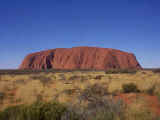 June 14-22, 1999 Northern Territory Outback,
Australia June 14-22, 1999 Northern Territory Outback,
AustraliaUluru (Ayers Rock)
It's the end of a long and tiring day on the road. The fuzzy memory of an energetic
"G'mornin mate, looks to be a fan-tastic day!" from our driver Steve at 4:30
this morning, seems more like 12 days, rather than 12 hours ago. But now, the good news is
that our only duty left in the day is to just relax and enjoy our trek's hard-earned
reward - sunset at one of the most majestic and mysterious spots in all of Australia: the
base of Uluru, or Ayers Rock.
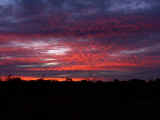 This majestic monolith is most magical at
sunset, revealing its many moods through its changing colors of both rock and surrounding
sky. Over one shoulder, the fading light of the gradually descending sun sets the sky
afire with scarlet, crimson, and glowing-orange hues. Over the other, the same light
creates shadows that move and dance over the crevasses, cracks, and depressions of a
rust-red Uluru. I'm humbled. I'm awe-struck. I'm pensive. This majestic monolith is most magical at
sunset, revealing its many moods through its changing colors of both rock and surrounding
sky. Over one shoulder, the fading light of the gradually descending sun sets the sky
afire with scarlet, crimson, and glowing-orange hues. Over the other, the same light
creates shadows that move and dance over the crevasses, cracks, and depressions of a
rust-red Uluru. I'm humbled. I'm awe-struck. I'm pensive.
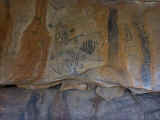 I
think about how it must've been a sight just like this one, sunset at the close of a day,
maybe tens of thousands of years ago, that inspired the Aboriginal elders to reach
awareness and begin to concoct and relate their dreamtime stories. These tales, stories
that explained creation and outlined Aboriginal laws, also did well to weave an
imaginatively rich realm into existence, filling the Uluru area, and the rest of the arid
and barren domain of the outback, with magic and life. The stories explained all that is
the outback - Uluru itself, the rivers, deserts, animals, plants, even the stars adorning
the evening sky. I
think about how it must've been a sight just like this one, sunset at the close of a day,
maybe tens of thousands of years ago, that inspired the Aboriginal elders to reach
awareness and begin to concoct and relate their dreamtime stories. These tales, stories
that explained creation and outlined Aboriginal laws, also did well to weave an
imaginatively rich realm into existence, filling the Uluru area, and the rest of the arid
and barren domain of the outback, with magic and life. The stories explained all that is
the outback - Uluru itself, the rivers, deserts, animals, plants, even the stars adorning
the evening sky.
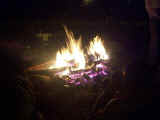 And it's those very stars that now hold my
thoughts and attentions, as we lay here, gazing into an seemingly endless expanse of them.
They're all ablaze, glowing like tiny diamond chips and dust, scattered over the deepest
of dark blue velvet. "Whoa! did you see that?" Laura gasps. "Ohhh,
there's another one!" "What?" I ask. "You didn't see them? Two
shooting stars - all the way across the sky - from over there." "See, now
aren't you glad I wouldn't let you sleep on the picnic tables under that shelter, or worse
yet in the bus, like you wanted to?" "Yeah, I guess so" she answers
quietly. "All those stories from around the campfire about snakes and wild dingoes
are just that, crazy stories." I try to comfort her. "Don't worry, between these
swags (a uniquely Australian, canvas sleeping bag enclosure) and the fire, we'll be safe
and sound." At least in theory we're well protected from the two biggest dangers of
sleeping in the desert, the cold, crisp night air, and the multitude of wandering rodents.
I hope that theory holds, I think to myself as I gaze into the serenity of the vast
nothingness of the night sky above and drift off to sleep. And it's those very stars that now hold my
thoughts and attentions, as we lay here, gazing into an seemingly endless expanse of them.
They're all ablaze, glowing like tiny diamond chips and dust, scattered over the deepest
of dark blue velvet. "Whoa! did you see that?" Laura gasps. "Ohhh,
there's another one!" "What?" I ask. "You didn't see them? Two
shooting stars - all the way across the sky - from over there." "See, now
aren't you glad I wouldn't let you sleep on the picnic tables under that shelter, or worse
yet in the bus, like you wanted to?" "Yeah, I guess so" she answers
quietly. "All those stories from around the campfire about snakes and wild dingoes
are just that, crazy stories." I try to comfort her. "Don't worry, between these
swags (a uniquely Australian, canvas sleeping bag enclosure) and the fire, we'll be safe
and sound." At least in theory we're well protected from the two biggest dangers of
sleeping in the desert, the cold, crisp night air, and the multitude of wandering rodents.
I hope that theory holds, I think to myself as I gaze into the serenity of the vast
nothingness of the night sky above and drift off to sleep.
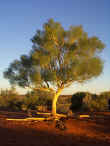 Dusk the next night finds us out, once
again to celebrate sunset over Uluru. This time there's a short climb to our vantage
point, a small sandhill rising just slightly above the surrounding flatness of the desert.
With each step, our feet squeak on the rippled crust of the red grains. That muffled
crunching is the only sound in this, the stillness of the day's half-light. As we reach
the top, I smile to see a single tree, sprouting from the absolute center of the mound,
undisputedly claiming this highpoint as its own. Dusk the next night finds us out, once
again to celebrate sunset over Uluru. This time there's a short climb to our vantage
point, a small sandhill rising just slightly above the surrounding flatness of the desert.
With each step, our feet squeak on the rippled crust of the red grains. That muffled
crunching is the only sound in this, the stillness of the day's half-light. As we reach
the top, I smile to see a single tree, sprouting from the absolute center of the mound,
undisputedly claiming this highpoint as its own.
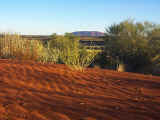 The red sand down each side of the hill is scattered with spiky
spinfex grass and other scrub, the telling tracks of insects, and the lizards who were
searching them out, evident between the plants. Even in the distance, the well over 1,000
feet high Uluru still maintains its massive appearance. I reach over for Laura's hand as
we sit here, and once again, watch the giant sacred rock work its awe-inspiring sunset
magic. The red sand down each side of the hill is scattered with spiky
spinfex grass and other scrub, the telling tracks of insects, and the lizards who were
searching them out, evident between the plants. Even in the distance, the well over 1,000
feet high Uluru still maintains its massive appearance. I reach over for Laura's hand as
we sit here, and once again, watch the giant sacred rock work its awe-inspiring sunset
magic.
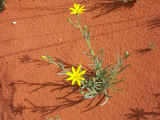 Kata Tjata (The Olgas) Kata Tjata (The Olgas)
This morning, we're treated to a walk through another sacred site of the Aboriginal
people, that of Kata Tjata, or what the white settlers have dubbed The Olgas. The
Aboriginal translation of Kata Tjata, 'many heads', seems an accurate description for the
36 gigantic domes that make up this landscape. At one time, this entire plat was most
likely covered with one huge mound.
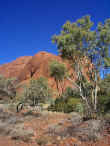 But
today, the big, smooth, rounded masses of rock are separated with countless crevasses,
some wide enough even to be called valleys. The widest of these, the Valley of the Winds,
provides the path of our explorations. On either side of the chasm, towering rust-red rock
walls rise to meet the contrasting indigo blue sky. And down here within the basin, sparse
foliage, both black and green - dead and alive, provides the scenery. In this, the driest
of dry climates, little plant life survives for more than a few decades. But
today, the big, smooth, rounded masses of rock are separated with countless crevasses,
some wide enough even to be called valleys. The widest of these, the Valley of the Winds,
provides the path of our explorations. On either side of the chasm, towering rust-red rock
walls rise to meet the contrasting indigo blue sky. And down here within the basin, sparse
foliage, both black and green - dead and alive, provides the scenery. In this, the driest
of dry climates, little plant life survives for more than a few decades.
 And
even then, when these hardy trees do die, they still remain upright, refusing to fall or
decay for sometimes even decades more. We now walk among them, finding them stubbornly
standing as they always have, stiff and still, their now lifeless limbs still scraping
their contorted fingers across the cloudless blue sky, seemingly grasping for any drop of
moisture that they can grab. And
even then, when these hardy trees do die, they still remain upright, refusing to fall or
decay for sometimes even decades more. We now walk among them, finding them stubbornly
standing as they always have, stiff and still, their now lifeless limbs still scraping
their contorted fingers across the cloudless blue sky, seemingly grasping for any drop of
moisture that they can grab.
Watarrka (King's Canyon)
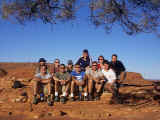 This,
the last morning of our outback roaming, finds us climbing the rugged trails of the
sunburnt Watarrka, or King's Canyon. Looking more like the surface of Mars than a slice of
the Australian Outback, the red and rugged, strange and unfamiliar landscape of the canyon
area has me wondering how anything can possibly exist in such a bizarre and harsh
environment. This,
the last morning of our outback roaming, finds us climbing the rugged trails of the
sunburnt Watarrka, or King's Canyon. Looking more like the surface of Mars than a slice of
the Australian Outback, the red and rugged, strange and unfamiliar landscape of the canyon
area has me wondering how anything can possibly exist in such a bizarre and harsh
environment.
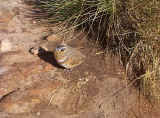 Little moves out here, with the possible
exception of the shimmering heat-haze rising from the crests of the rust rock walls. There
is little sign of life, with the odd exception of a spinflex pigeon or two wandering
aimlessly around the scattered trees, trees that must spend their days clinging stubbornly
to life. Little moves out here, with the possible
exception of the shimmering heat-haze rising from the crests of the rust rock walls. There
is little sign of life, with the odd exception of a spinflex pigeon or two wandering
aimlessly around the scattered trees, trees that must spend their days clinging stubbornly
to life.
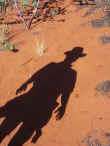 As we walk along, oddly, I take notice of
my shadow. Step after step, it's my almost constant companion under the bright desert sun.
First, he's long and tall, as we both have a certain bounce in our step during our morning
explorations. By midday, he appears to hide beneath my feet, tired and escaping the
hottest hours under the sun's most direct rays. And now, with mid-afternoon, we've both
gotten a second wind. His steps, as they mimic mine, are long, and again full of energy. As we walk along, oddly, I take notice of
my shadow. Step after step, it's my almost constant companion under the bright desert sun.
First, he's long and tall, as we both have a certain bounce in our step during our morning
explorations. By midday, he appears to hide beneath my feet, tired and escaping the
hottest hours under the sun's most direct rays. And now, with mid-afternoon, we've both
gotten a second wind. His steps, as they mimic mine, are long, and again full of energy.
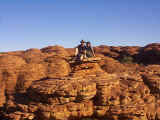 Hum, I think, almost like it's all a curious sort of cycle.
Funny how these days in the Outback seem to be like that. They wake you with a shake, then
lead you around until you're drained of energy. Once you've absolutely had it, they jazz
you back up with a brilliant light display at dusk, and follow that with a cold, night-air
slap in the face. Nothin' like it anywarz else in the world, ay mate? Hum, I think, almost like it's all a curious sort of cycle.
Funny how these days in the Outback seem to be like that. They wake you with a shake, then
lead you around until you're drained of energy. Once you've absolutely had it, they jazz
you back up with a brilliant light display at dusk, and follow that with a cold, night-air
slap in the face. Nothin' like it anywarz else in the world, ay mate?
|



